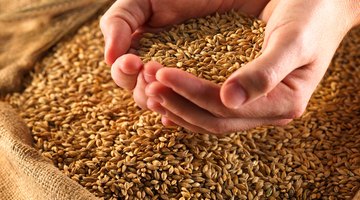The Neolithic Revolution marks the change from nomadic hunting and gathering to a settled life in small villages 12,000 years ago, which led to the development of agriculture and the domestication of animals. Living life in year-round, permanent dwellings led to changes in the neolithic culture and how society was organized, the kinds of laws that were practiced, as well as property rights and protection of territory. It also created specialization, innovation and trade. These economic and cultural changes ultimately allowed for the growth of urban civilization. Neolithic revolution information is abundant thanks to evidence discovered at archaeological sites.
Neolithic Revolution Facts about Agriculture
Due to shifts in climate around 10,000-8300 B.C.in the Mediterranean, wild wheat and barley became widely available, encouraging populations to settle down in small communities where the crops were abundant. A second shift in climate around 9000 B.C. caused a decrease in these wild strains, which then encouraged Neolithic people to maximize the crops they had by improving their growing methods, actively tending the crops, selectively breeding them and saving seeds. This focus on method led to the rise of agriculture and the domestication of dogs, sheep, goats, cattle and pigs.
Changes to Neolithic Culture
The establishment of permanent homes changed dramatically the nomadic way of life. The importance of land created the need not only for laws to arbitrate but a system of writing to record, organize and adjudicate. With a surplus of food, more specialization was possible and larger populations centered around the farming community, increasing communication, connectivity, innovation and stability. Religious rituals also created economic and social stability. Gil Stein, Director of the Oriental Institute of the University of Chicago, suggests that the practice of burying the dead underneath the floors of their homes solidified land rights by justifying control of a certain piece of land with the ancestors who were buried there.
Problems with Settling Down
Although the rise of agriculture allowed for food surplus and specialization, it also brought with it some problems, including class stratification, gender labor division and land dependence. A more organized and systematized way of life led to agricultural hierarchies that created upper classes who benefited from the work of laborers. The change in how work was done also led to a division in gender roles with men working in the public sphere and women in the private sphere. With close proximity to other humans and animals as well as poor sanitation, disease became a danger, as did a higher dependence on the land and its consequent threats: drought, fire and territoriality.
Salt and Trade
Nevertheless, the Neolithic Revolution brought with it structure, stability and resource surplus. Eating meat more regularly required new ways to preserve it, including the use of salt, which was a vitally important resource for pre-modern societies. Salt dried out the meat, allowing it to be preserved through the winter. Salt became one of the commodities traded between communities, and with the advent of trade, networking and sharing of information further increased societal and cultural exchange that began with the advent of agriculture and permanent settlements.
Related Articles
References
Writer Bio
John Conway is a professor and writer who has been teaching for more than 15 years. He has written about a variety of subjects, including technology, science, literary theory, online education and culture. Conway holds an M.F.A. in creative writing and a Ph.D. in English.











